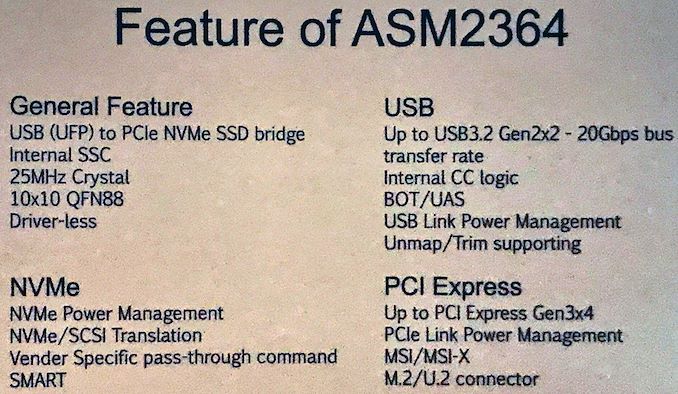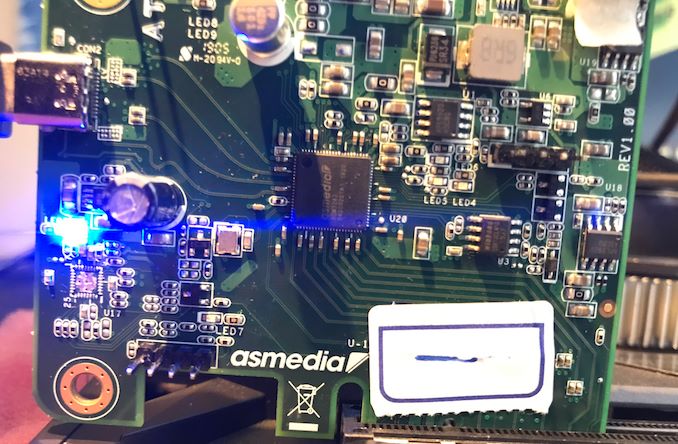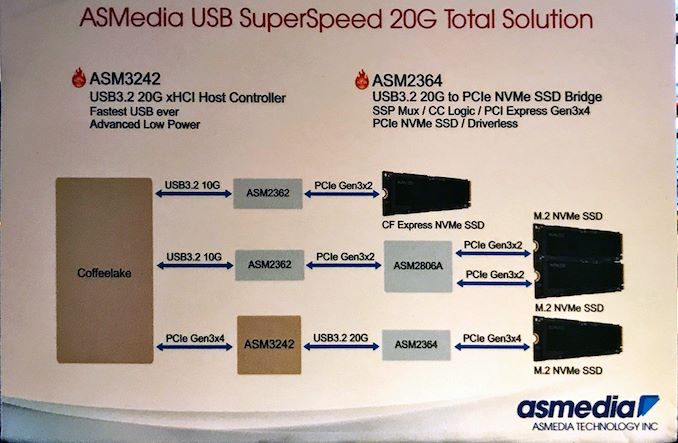ASMedia Demonstrates ASM3242 USB 3.2 2x2 Controller: Available in August
by Anton Shilov on May 29, 2019 5:00 PM EST- Posted in
- Peripherals
- Trade Shows
- USB
- ASMedia
- USB 3.2
- Computex 2019
- ASM3242

ASMedia has finished development of its USB 3.2 2x2 controller and will make it available to makers of motherboards in the coming months. The company is demonstrating cards featuring its ASM3242 chip at Computex, so the controller is indeed ready for prime time.
ASMedia’s ASM3242 USB 3.2 2x2 controller uses a PCIe 3.0 x4 interface to ensure maximum amount of bandwidth it can provide to USB peripherals, 20 Gb/s in the case of this particular standard. As usual with ASMedia, the ASM3242 was designed completely in-house, it has the company’s own PHY and control logic.
The USB 3.2 uses two high-speed USB Type-C Tx/Rx channels to achieve 20 Gbps maximum throughput, thus retaining the USB 3.1 physical layer data rates and encoding techniques, but just using additional wires found in USB Type-C cables that would otherwise be used for various alternative modes (Alt Modes).
ASMedia says that it will start shipments of the ASM3242 to interested parties in mass quantities this August, so the first PCs featuring the controller will be available this Fall, around two years after the USB 3.2 2x2 specification was finalized.
While the USB4 technology is knocking the door, it is not quite here yet. The current version of the specification is 0.96 and the final one is expected to arrive later this summer if everything goes as planned. Once the spec is finalized, it will take developers of controllers at least 18 months to design appropriate chips and bring them to market (i.e., we are at least 1.5 – 2 years away from USB4-enabled PCs). That said, for people looking for high-speed USB connectivity the USB 3.2 2x2 technology is a way to go, which is why for makers of PCs and motherboards it makes a great sense to offer USB 3.2 2x2 connectivity on their products this year.
| Want to keep up to date with all of our Computex 2019 Coverage? | ||||||
 Laptops |
 Hardware |
 Chips |
||||
| Follow AnandTech's breaking news here! | ||||||













12 Comments
View All Comments
LauRoman - Wednesday, May 29, 2019 - link
Those traces though?DanNeely - Wednesday, May 29, 2019 - link
That looks like a dev board, not a production design (going off the internal barrel connector in the one picture). The layout was probably done with the intent of making it easy to tinker with (possibly to the extent of swapping in arbitrary control chips and output ports while being able to leave the debug hardware unchanged) not compact.bubblyboo - Wednesday, May 29, 2019 - link
He obviously meant the curved traces, most likely that one on the bottom that's not only curved but also has a hump for some reason.Death666Angel - Wednesday, May 29, 2019 - link
If I understand what you mean, the "hump" ensures that all the traces are the same length, thus the signal arrives at the same time. It is a dev board so there is a lot of space and it is very obvious. Retail stuff hides this more by being much more dense in a smaller area.shabby - Wednesday, May 29, 2019 - link
Ugly I know, not buying it because of that..imaheadcase - Wednesday, May 29, 2019 - link
What is ugly about something that you never will see? lolshabby - Wednesday, May 29, 2019 - link
Forgot the /ssheh - Thursday, May 30, 2019 - link
Also only one LED, and not RGB. :(edzieba - Thursday, May 30, 2019 - link
Yeah, the funky routing was the first thing I noticed. Not the path-length-mathcing chicaning - that's standard fare - but that the traces are curved rather than angled. Welcome to the realm of ultra-high-frequency routing, I guess. Expect to see more of this with PCIe 4.0 and 5.0.arashi - Thursday, May 30, 2019 - link
Wonder if they could add a DP in on the back of the card so you can still use alt mode with a non 3.2x2 device.